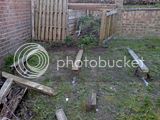Crikey !
BSM, that's certainly a definate explanation of "Coach Screw" nice pic
I built a 20 x 10 Workshop 10 years ago, and put it together with them, they really are more substantial than a normal screw.
I like the SDS idea :wink: I did it with a ratchet

as if a mans right arm needs all that exercise :lol:
Regarding the timber bowing, cut a point on one of your timbers, and make a stake, hammer it into the ground ( depending on your soil you may have to dig a hole and backfill, but it will need to be longer, to account for soil structure being disturbed) in the midle of your walls, and screw from the inside to the outer timbers, that will prevent bowing in the middle, you can use more if required spread equally, and another tip is to line the inside first with weed suppressing fabric, and then plastic inside that, it prevents weeds germinating through from outside, and helps the plastic from getting ripped / torn inside.
It's a nice project raised planters, I'll keep an eye on this one :wink:
Cheers
Jed











